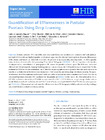Quantification of Efflorescences in Pustular Psoriasis Using Deep Learning
dc.contributor.author
Amruthalingam, Ludovic
dc.contributor.author
Buerzle, Oliver
dc.contributor.author
Gottfrois, Philippe
dc.contributor.author
Gonzalez Jimenez, Alvaro
dc.contributor.author
Roth, Anastasia
dc.contributor.author
Koller, Thomas
dc.contributor.author
Pouly, Marc
dc.contributor.author
Navarini, Alexander A.
dc.date.accessioned
2022-09-05T09:03:18Z
dc.date.available
2022-08-31T03:11:20Z
dc.date.available
2022-09-05T09:03:18Z
dc.date.issued
2022
dc.identifier.issn
2093-3681
dc.identifier.issn
2093-369X
dc.identifier.other
10.4258/hir.2022.28.3.222
en_US
dc.identifier.uri
http://hdl.handle.net/20.500.11850/567763
dc.identifier.doi
10.3929/ethz-b-000567763
dc.description.abstract
Objectives: Pustular psoriasis (PP) is one of the most severe and chronic skin conditions. Its treatment is difficult, and measurements of its severity are highly dependent on clinicians’ experience. Pustules and brown spots are the main efflorescences of the disease and directly correlate with its activity. We propose an automated deep learning model (DLM) to quantify lesions in terms of count and surface percentage from patient photographs. Methods: In this retrospective study, two dermatologists and a student labeled 151 photographs of PP patients for pustules and brown spots. The DLM was trained and validated with 121 photographs, keeping 30 photographs as a test set to assess the DLM performance on unseen data. We also evaluated our DLM on 213 unstandardized, out-of-distribution photographs of various pustular disorders (referred to as the pustular set), which were ranked from 0 (no disease) to 4 (very severe) by one dermatologist for disease severity. The agreement between the DLM predictions and experts’ labels was evaluated with the intraclass correlation coefficient (ICC) for the test set and Spearman correlation (SC) coefficient for the pustular set. Results: On the test set, the DLM achieved an ICC of 0.97 (95% confidence interval [CI], 0.97–0.98) for count and 0.93 (95% CI, 0.92–0.94) for surface percentage. On the pustular set, the DLM reached a SC coefficient of 0.66 (95% CI, 0.60–0.74) for count and 0.80 (95% CI, 0.75–0.83) for surface percentage. Conclusions: The proposed method quantifies efflorescences from PP photographs reliably and automatically, enabling a precise and objective evaluation of disease activity.
en_US
dc.format
application/pdf
en_US
dc.language.iso
en
en_US
dc.publisher
KOSMI
en_US
dc.rights.uri
http://creativecommons.org/licenses/by-nc/4.0/
dc.title
Quantification of Efflorescences in Pustular Psoriasis Using Deep Learning
en_US
dc.type
Journal Article
dc.rights.license
Creative Commons Attribution-NonCommercial 4.0 International
dc.date.published
2022-07-31
ethz.journal.title
Healthcare Informatics Research
ethz.journal.volume
28
en_US
ethz.journal.issue
3
en_US
ethz.pages.start
222
en_US
ethz.pages.end
230
en_US
ethz.version.deposit
publishedVersion
en_US
ethz.identifier.wos
ethz.identifier.scopus
ethz.publication.place
Seoul
en_US
ethz.publication.status
published
en_US
ethz.date.deposited
2022-08-31T03:11:23Z
ethz.source
SCOPUS
ethz.eth
yes
en_US
ethz.availability
Open access
en_US
ethz.rosetta.installDate
2022-09-05T09:03:26Z
ethz.rosetta.lastUpdated
2023-02-07T05:58:26Z
ethz.rosetta.versionExported
true
ethz.COinS
ctx_ver=Z39.88-2004&rft_val_fmt=info:ofi/fmt:kev:mtx:journal&rft.atitle=Quantification%20of%20Efflorescences%20in%20Pustular%20Psoriasis%20Using%20Deep%20Learning&rft.jtitle=Healthcare%20Informatics%20Research&rft.date=2022&rft.volume=28&rft.issue=3&rft.spage=222&rft.epage=230&rft.issn=2093-3681&2093-369X&rft.au=Amruthalingam,%20Ludovic&Buerzle,%20Oliver&Gottfrois,%20Philippe&Gonzalez%20Jimenez,%20Alvaro&Roth,%20Anastasia&rft.genre=article&rft_id=info:doi/10.4258/hir.2022.28.3.222&
Files in this item
Publication type
-
Journal Article [128857]

